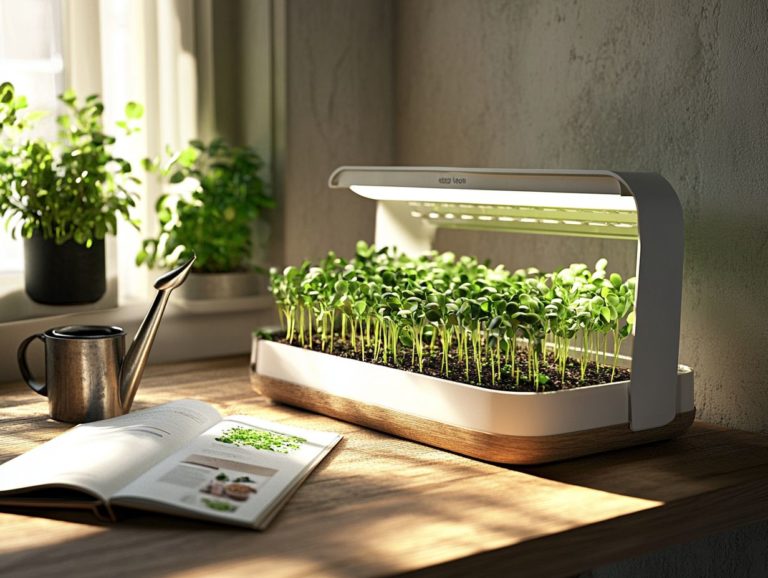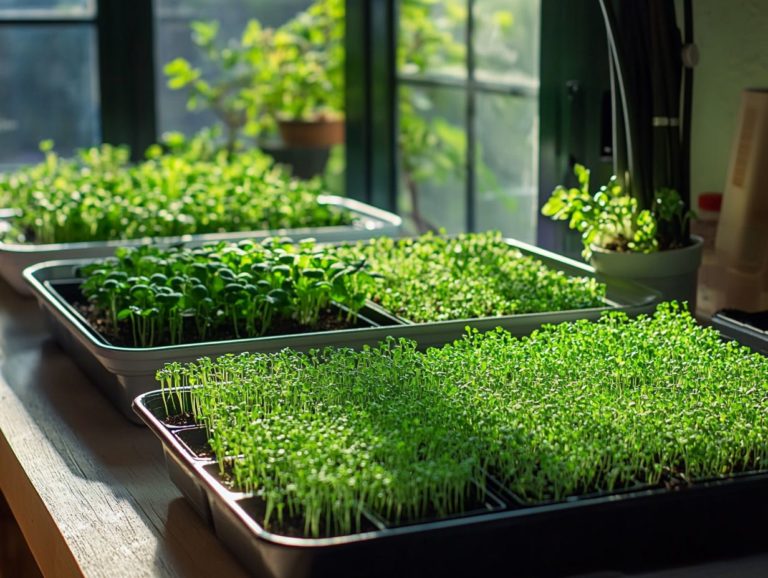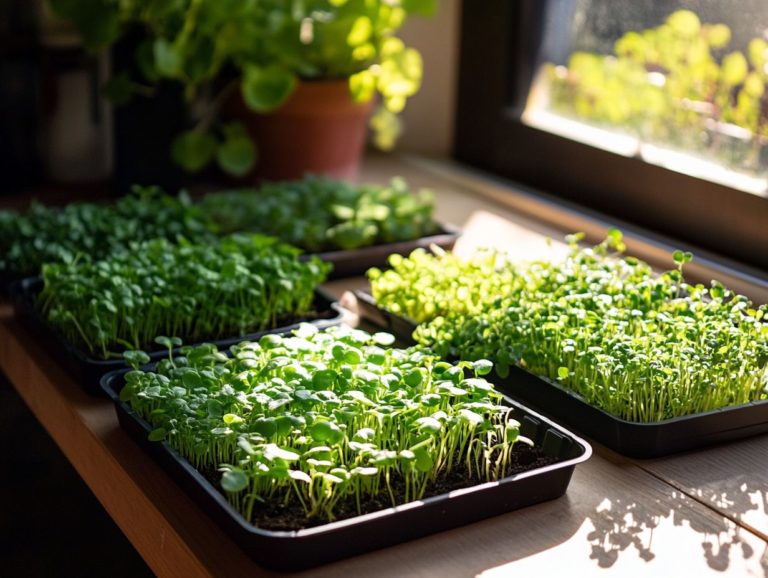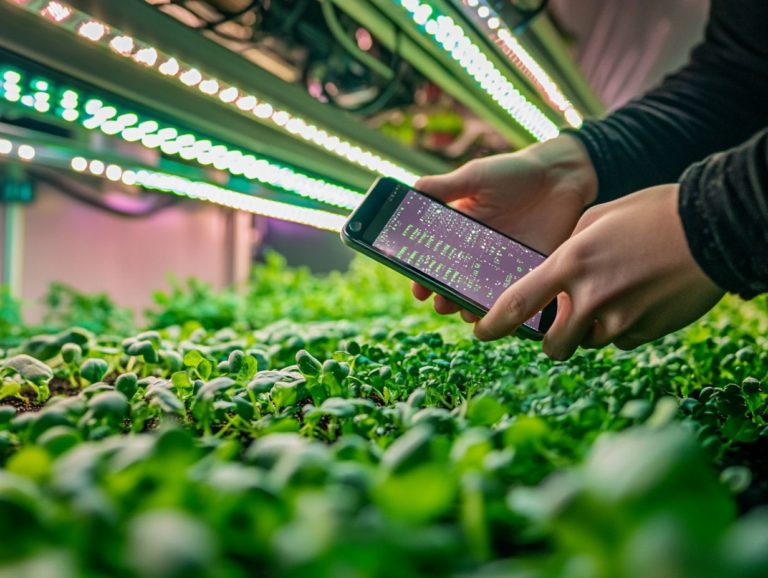How to Choose Microgreen Supplies for Beginners
Microgreens have truly transformed the culinary landscape, known for their great flavors and impressive nutrients.
If you’re intrigued by the idea of growing these small plants at home, this guide includes everything you need from understanding microgreens and gathering essential supplies to selecting the perfect seeds and preparing an optimal growing medium.
You will also find a detailed guide to planting, nurturing, harvesting, and storing your greens.
Whether you’re a seasoned gardener or just starting out, jump into the exciting world of microgreens today!
Contents
- Key Takeaways:
- What are Microgreens?
- Supplies Needed for Growing Microgreens
- Choosing the Right Seeds
- Preparing the Growing Medium
- Planting and Caring for Microgreens
- Harvesting and Storing Microgreens
- Frequently Asked Questions
- Wondering how to get started with microgreens? What are the most important factors to consider when choosing microgreen supplies for beginners?
- What type of microgreens are best for beginners?
- How much space do I need for growing microgreens?
- Do I need special equipment for growing microgreens?
- Can I grow microgreens without soil?
- How much should I budget for purchasing microgreen supplies?
Key Takeaways:
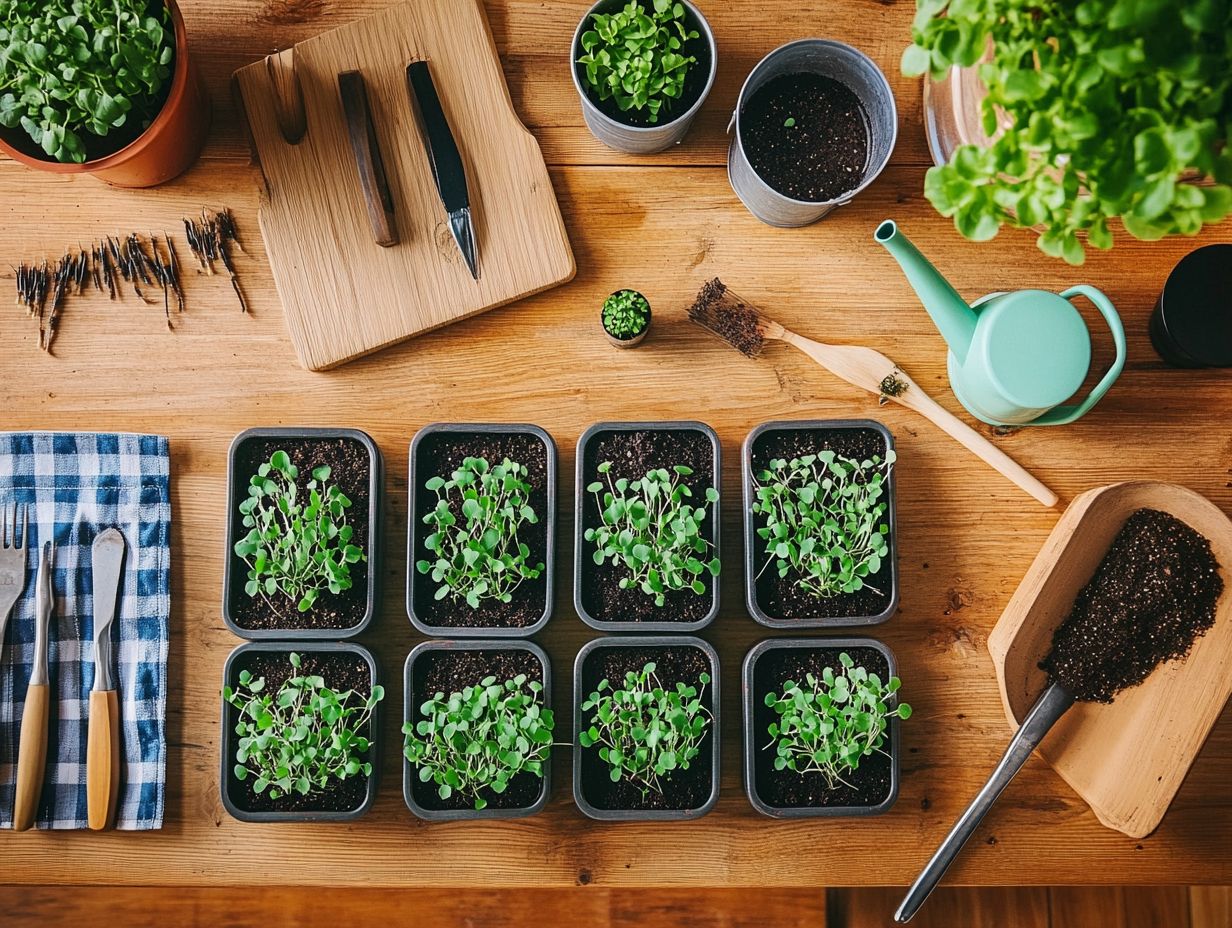
- Start with the right equipment and materials when growing microgreens. This includes trays, soil, and seeds, among others.
- Consider factors like growth time, flavor, and availability when choosing microgreen seeds. Opt for organic and non-GMO options for healthier and tastier microgreens.
- Properly preparing the growing medium is crucial for the success of your microgreens. Pick soil, coco coir, or hydroponic options based on what you prefer.
What are Microgreens?
Microgreens are young, edible plants bursting with flavor, nutrients, and vibrant colors. They ve captured the hearts of urban gardeners and health enthusiasts alike, making them a popular choice for home microgreens.
These petite greens, often harvested shortly after germination, are typically cultivated from a variety of seeds, including peas, sunflowers, broccoli, and parsley. They offer a sustainable and effortless way to grow nutritious food right in your own home.
With their rapid growth cycle, microgreens present an excellent opportunity for indoor gardening. This allows those new to the practice to enjoy fresh microgreens throughout the year.
Definition and Benefits
Microgreens are the small, edible seedlings of vegetables and herbs, harvested within 7 to 21 days after germination. They re celebrated for their intense flavors and remarkable nutrient density, often enhanced by a nutrient solution rich in essential elements.
These tiny greens deliver a powerful nutritional punch, often containing higher concentrations of vitamins and minerals than their mature counterparts. Take broccoli microgreens, for example; they are rich in sulforaphane, a compound renowned for its antioxidant properties that help combat oxidative stress in your body.
Incorporating these vibrant little plants into your daily meals is easy. Just sprinkle them on salads, blend them into smoothies, or use them as a garnish for soups to enhance both the flavor and nutritional profile of your dishes. For those interested in growing their own, check out this guide on how to create a microgreen grow kit, especially with easy microgreens varieties.
Supplies Needed for Growing Microgreens
To successfully cultivate microgreens at home, you’ll want to gather specific supplies and equipment that streamline the germination process and create ideal growth conditions. This includes high-quality microgreen trays, suitable growing media, and essential hydroponic nutrients such as pH down and other necessary components to nurture your plants.
Essential Equipment and Materials
The essential equipment for growing microgreens includes microgreen trays, a suitable growing medium, hydroponic nutrients, and effective watering tools.
Each component plays a vital role in your overall success in the growing process. High-quality microgreen trays, for instance, are crucial; they offer adequate drainage and support for those delicate seedlings while making harvesting a breeze.
Choosing the right growing medium is equally important, as it directly influences moisture retention and root development. Hydroponic nutrients are essential for enhancing nutrient uptake, ensuring your microgreens flourish robustly.
Using the proper watering techniques like employing a gentle spray or a watering can with a fine nozzle will help you maintain soil moisture without risking over-saturation of the roots, which can lead to rot. With this careful attention, you’ll grow a lush microgreen garden that will amaze you! To further enhance your gardening skills, check out this guide on how to maximize yields from microgreens.
Choosing the Right Seeds
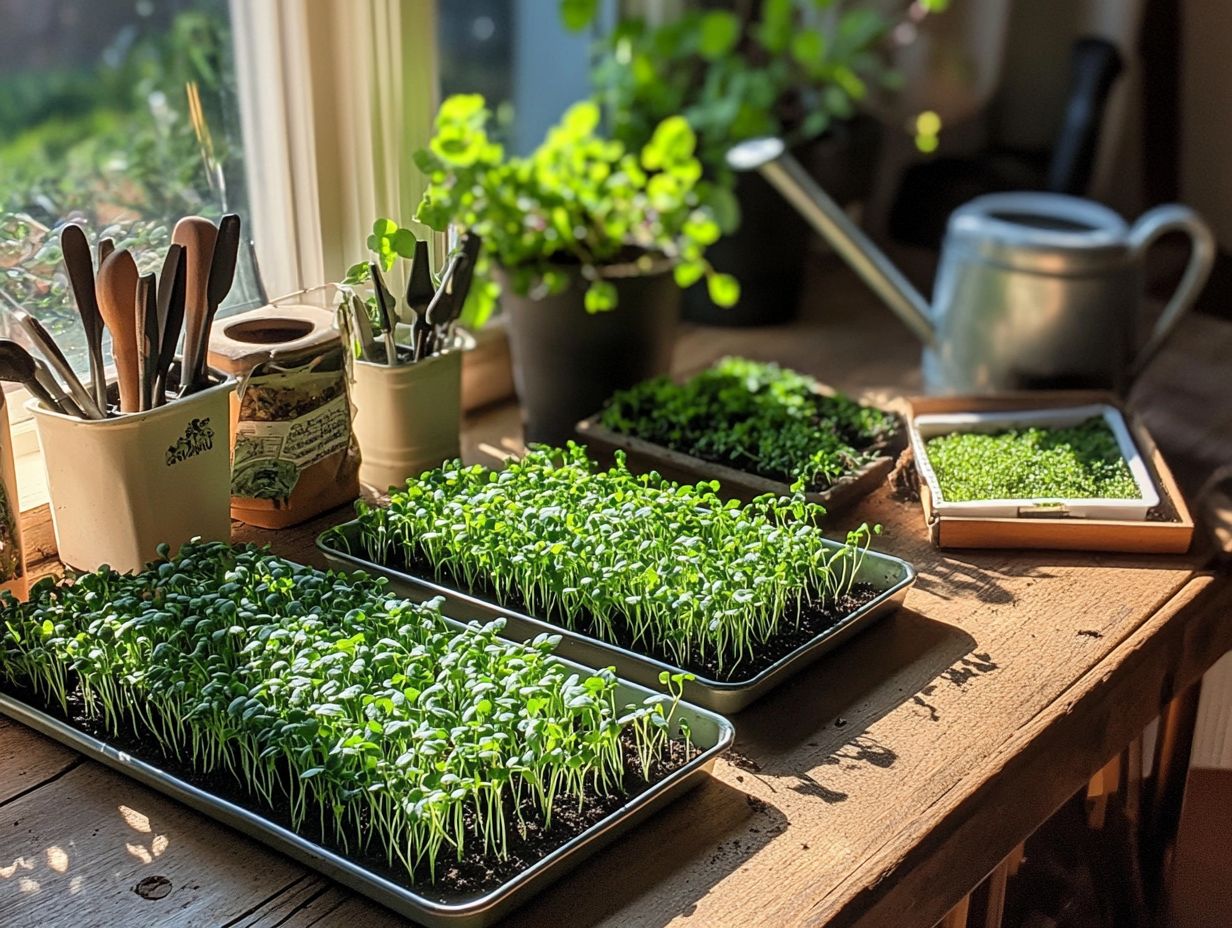
Choosing the right microgreen seeds is an exciting first step that influences your entire growing journey. It impacts both the flavor profile and the ease of cultivation, especially when considering seed density.
With a diverse array of options at your fingertips, from peas to radishes and sunflowers, each variety offers unique qualities and delights. Don t miss out on the amazing flavors you can create with these varieties!
Factors to Consider
Let s dive into what you need to think about when selecting your seeds. When choosing microgreen seeds, consider several key factors, including growing conditions, seed density, and the flavors you want for a successful harvest.
Start by assessing the growing conditions. Take note of the light levels in your space; microgreens generally flourish in bright, indirect sunlight or under grow lights. Temperature is equally important; aim for a range between 60 F and 75 F for optimal growth. Additionally, understanding how to choose the right soil for microgreen growth can further enhance your success.
Don t underestimate the significance of seed density. A helpful rule of thumb is to scatter seeds evenly across the growing medium. Avoid overcrowding to ensure adequate air circulation and access to nutrients.
When selecting seeds, think about the ways to use them in cooking to elevate your dishes, particularly in the context of hydroponics, a method of growing plants without soil. Explore delightful options, such as:
- Basil for a fresh garnish
- Radish for a peppery kick
These choices can enhance your culinary creations.
Preparing the Growing Medium
Preparing the optimal growing medium is crucial for successfully cultivating microgreens. It significantly influences both the germination process and the overall health of the plants, especially with sustainable media for better outcomes.
You have a variety of options, from traditional soil to sustainable alternatives like coconut coir and peat moss. Each offers unique benefits for your microgreen journey.
Best Growing Medium Options
The best growing medium options for microgreens include organic soil, coconut coir, and other sustainable materials that foster healthy growth with minimal hassle. Use 10×20 trays and 1010 trays for optimal planting.
Each of these mediums has distinct characteristics that can impact your success in cultivating microgreens. Organic soil excels in moisture retention and balanced pH levels, which are vital for various varieties. Coconut coir offers exceptional drainage while retaining enough moisture, making it a perfect choice for microgreens that thrive in less saturated conditions. For more insights, check out the best containers for microgreen cultivation.
Sustainable alternatives like peat moss or vermiculite provide lightweight aeration and efficient nutrient availability. Choosing the right medium often hinges on the specific microgreens you’re growing. For instance, delicate varieties may flourish in organic soil, while heartier types can benefit from coconut coir’s superior drainage. To enhance your growing experience, refer to this step-by-step guide to sowing microgreens tailored to your needs.
Planting and Caring for Microgreens
Planting and nurturing microgreens requires a meticulous approach. Follow specific steps from the germination phase to effective watering techniques.
This attention to detail ensures that these nutrient-rich plants flourish in their optimal environment, particularly when utilizing the right watering techniques.
Step-by-Step Guide
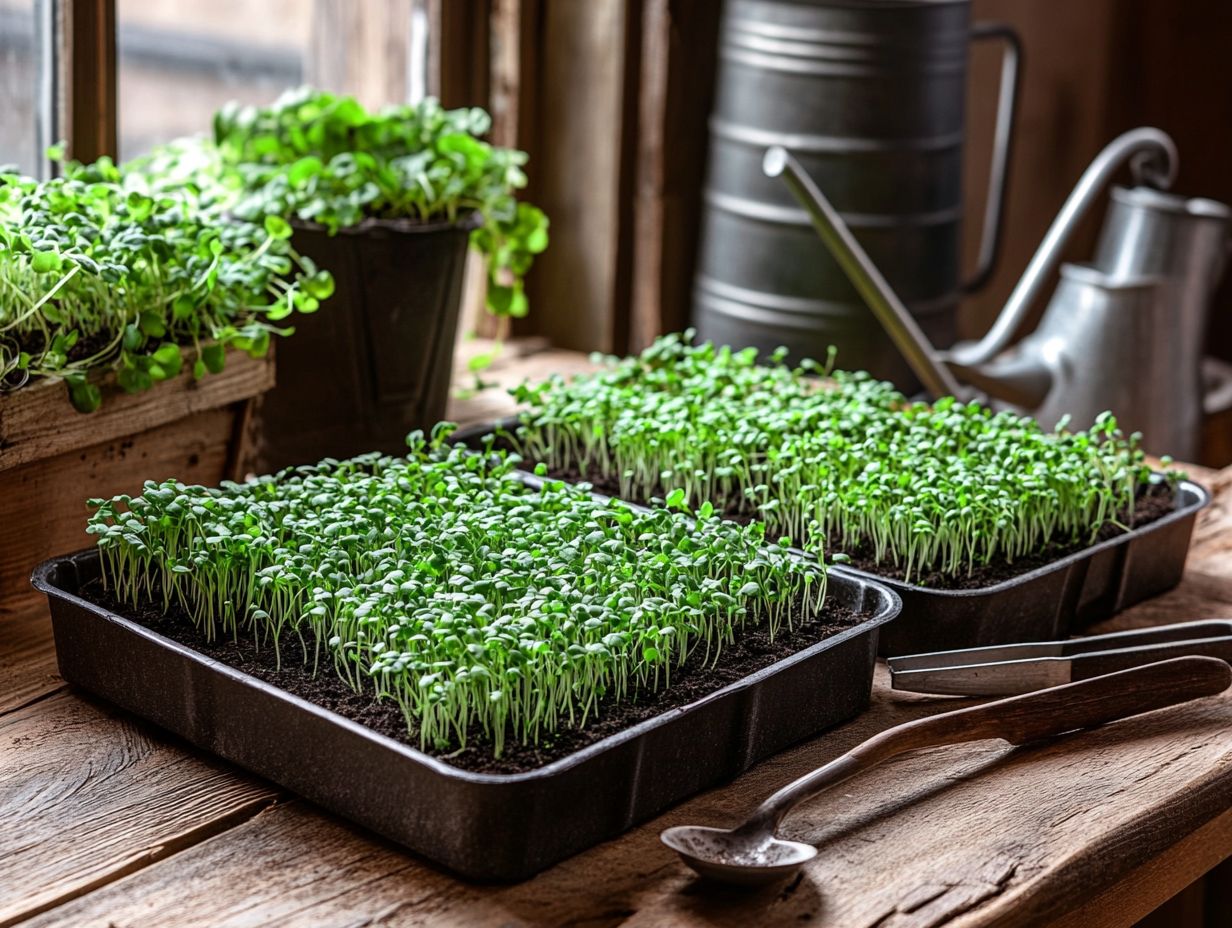
A step-by-step guide to planting microgreens starts with selecting your seeds and preparing your trays. Master the art of proper watering to foster successful growth.
Beyond these essential steps, manage light and temperature carefully. This helps your plants stay healthy. Once you ve sown the seeds in nutrient-rich soil, a light covering of soil aids in moisture retention.
Regularly check the moisture level. Both overwatering and underwatering can lead to issues like root rot or stunted growth.
For optimal watering, consider these tips:
- Use a spray bottle for gentle misting.
- Ensure your trays have proper drainage.
Watch for mold and pests. Addressing these problems quickly keeps your microgreens healthy. By incorporating these practices, you set yourself up for a bountiful and vibrant harvest.
Harvesting and Storing Microgreens
Harvesting and storing your microgreens carefully is vital! This keeps them fresh and packed with nutrients. By employing specific techniques, you can ensure they maintain optimal quality from garden to table, allowing you to enjoy fresh microgreens in your meals.
Tips for a Successful Harvest
To achieve a successful harvest of microgreens, adhere to a few key tips that maximize their freshness and ensure proper storage. This is essential for maintaining the benefits of their nutrient solution, which is a mix of water and nutrients that helps your plants grow healthy.
Timing is everything when it comes to harvesting. Microgreens are at their peak when they reach about 2-3 inches tall and showcase vibrant colors. When you cut them, use sharp scissors and snip just above the soil line. For those interested in enhancing their growing techniques, learning How to Use Hydroponics for Microgreens can be beneficial. This careful approach minimizes damage to the remaining plants, giving them a chance to regrow if you wish.
After harvesting, gently rinse the microgreens and thoroughly dry them to eliminate any excess moisture. This is key to avoiding spoilage. For storage, opt for a breathable container like a paper towel-lined box in the fridge. If you’re interested in maximizing your growing space, check out this guide on how to grow microgreens in a small space. This helps keep them crisp and flavorful for up to a week.
Frequently Asked Questions
Wondering how to get started with microgreens? What are the most important factors to consider when choosing microgreen supplies for beginners?
The most important factors are the type of microgreens you want to grow, the size of your growing space, and your budget.
What type of microgreens are best for beginners?
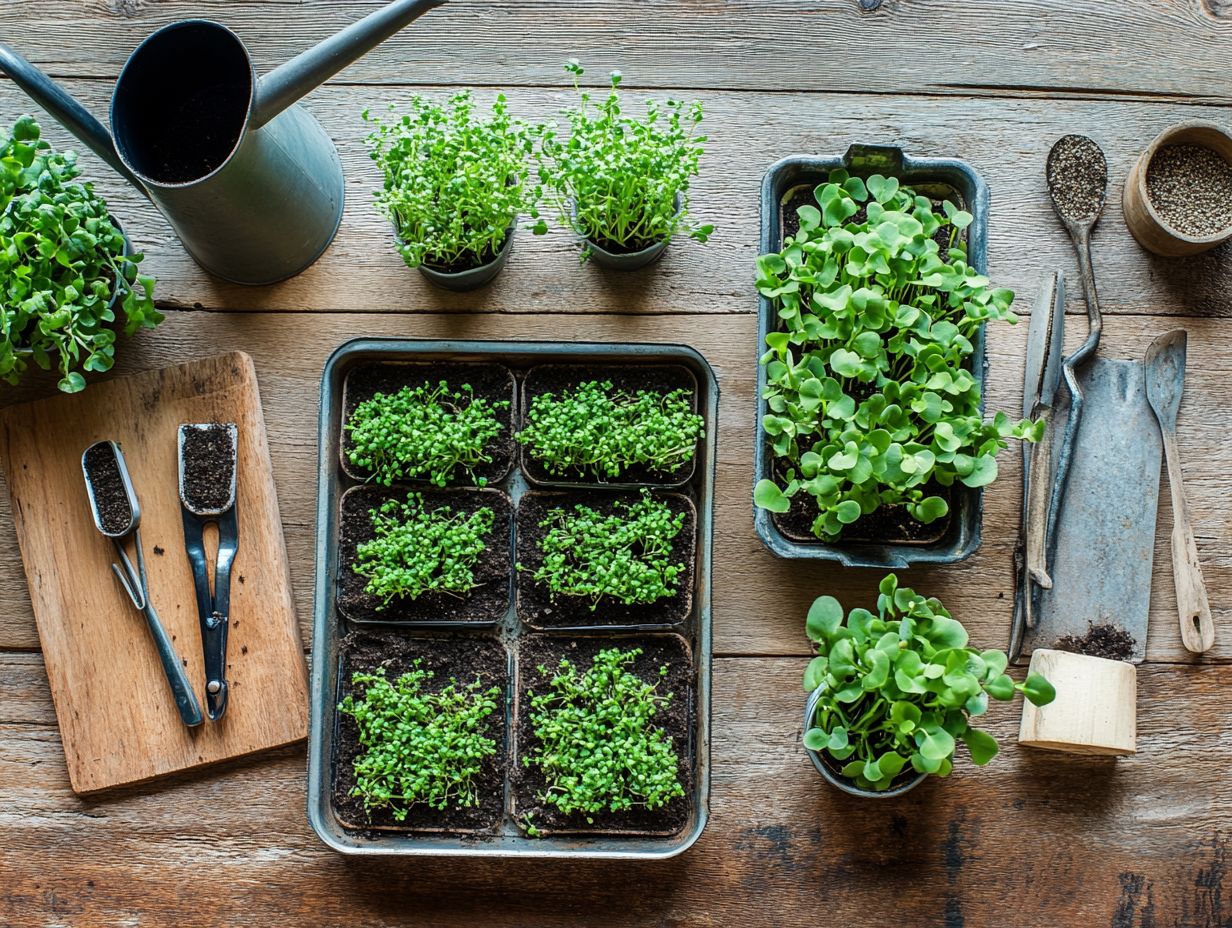
It is recommended for beginners to start with easy-to-grow microgreens such as broccoli, radish, or sunflower.
How much space do I need for growing microgreens?
This depends on how many microgreens you want to grow. A small tray or container can be used for a few servings, while a larger space is needed for commercial production.
Do I need special equipment for growing microgreens?
While not necessary, having a grow light or a seedling heat mat can help improve the growth of your microgreens. These can be purchased at a gardening store or online.
Can I grow microgreens without soil?
Yes, you can grow microgreens without soil using alternative growing mediums such as coconut coir, peat moss, or hydroponic systems.
How much should I budget for purchasing microgreen supplies?
This will depend on the size of your growing space and the type of supplies you choose. On average, beginners can expect to spend around $50-$100 for a basic setup.
Get started with your microgreens today and enjoy fresh greens in your meals!

